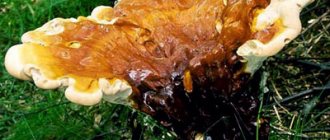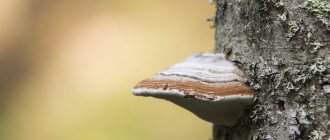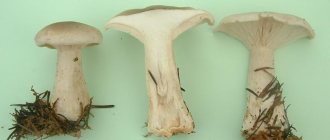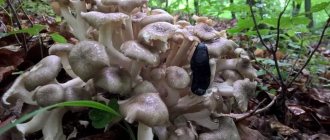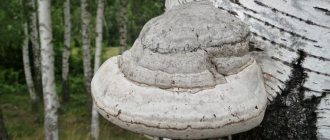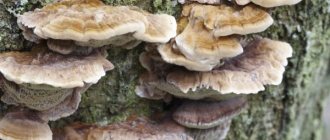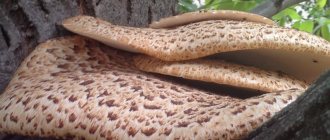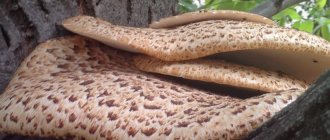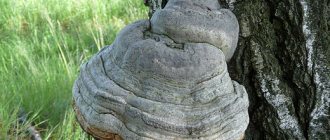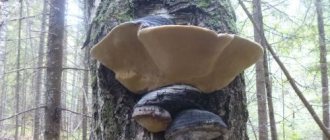Short description
| Type of mushrooms: | inedible, medicinal |
| Other names (synonyms): | Root sponge |
| Latin name: | Heterobasidion annosum |
| Family: | Bondarzewiaceae |
| Distinctive feature: | Heterobazidion perennial is an economically significant pathogenic fungus; it is an inedible but medicinal mushroom. It was first described as a root sponge back in 1821 and given the name Polyporus annosum. In 1874, the German forester Theodor Hartig was able to link this fungus to diseases of coniferous forests, so he renamed its name to Heterobasidion annosum. It is this name that is widely used today to designate the species of this mushroom. |
| Beginning of the season: | January |
| End of season: | December |
| Fruit body length (cm): | 5-15 cm |
| Fruiting body thickness (cm): | 3.5-4 cm |
| Smell: | fungal |
| Taste: | wood |
| Tasting score: | – |
| Fruit body: | often has an irregular shape. It is perennial. The shape can be the most bizarre, either prostrate or prostrate-bent, or hoof-shaped or shell-shaped. The upper ball of the mushroom has a concentrically grooved surface and is covered with a thin crust, which is light brown or chocolate brown in color. |
| Leg: | absent |
| Hymenophore (bottom of cap): | pores are small, round. The tubes are initially whitish, but later acquire a creamy white hue. A new layer of tubes grows within a year from 2 to 5 mm thick. |
| Disputes: | ellipsoidal or subglobulin, very small warty, 4.5-6 x 3.5-4.5 µm. |
| Pulp: | whitish to creamy, elastic, hard. |
| Natural environment and mycorrhiza: | can affect the following trees: fir, maple, larch, apple, pine, spruce, poplar, pear, oak, sequoia. It is most often found on gymnospermous tree species. |
| False doubles: | Heterobasidione fine-pore. Grows on spruce, fir, birch, larch trees and stumps, has smaller tubular pores. Heterobasidione insula. It is found in the Far East on the trunks of fir and deciduous trees. The tinder fungus is bordered. It is distinguished by a different shape of the fruiting body - it looks like incrustations of various shapes, as well as with larger pores of the hymenophore. |
| Growing: | – |
| Use: | do not eat. |
| Medicinal properties: | The fungus contains substances that have an antitumor effect. Tinctures from these mushrooms are used to treat pathologies of blood circulation in the brain and heart diseases. |
| Spreading: | in Eurasia and North America. |
In the kingdom of mushrooms, in total, there is a wide range of varieties, where each species is similar to each other, but at the same time they belong to completely different families. An excellent example in this case is the root sponge. Outwardly, it is very similar to tinder fungus and even has medicinal properties. But at the same time, he is classified as a member of the Bondartseviev family. The root sponge is a very interesting mushroom in its appearance.
Description
First of all, it is necessary to highlight the second name of the root sponge, which sounds like Heterobazidion perennial. As for the native Latin language, in this case Heterobasidion annosum.
The so-called fruiting bodies of such a mushroom are asymmetrical, that is, it is of uneven shape. Its structure does not include a leg. It is for this reason that it is attached to the tree with half of its base.
The fruiting bodies themselves can reach up to 15 cm in size, and its maximum thickness is 4 cm. If the mushroom grows together, it can grow up to 40 cm in length.
The root sponge has a shell-shaped cap. The main distinguishing feature is that it has a slight convexity at its edge. Such mushrooms can very often grow together.
We also cannot help but remember the uneven surface that these hats have. It is covered with a skin that is light brown in color.
The edges of the cap provide a contrast from the main color, as they have a shade that is close to yellow. If the body of the mushroom is young, then inside it there is mainly cork pulp, which is white or slightly pale.
Such a body begins to darken with age and also becomes more rigid, even to the point of having a wooden appearance. The bottom of the hat is represented by shiny tubes that peel off.
Every year there are more and more of them. From the very beginning they are white in color, then they become more creamy, but when pressed they begin to turn brown. Reproduction method: white spores.
Heterobasidion perennial (Heterobasidion annosum)
Taxonomy:
- Division: Basidiomycota (Basidiomycetes)
- Subdivision: Agaricomycotina (Agaricomycetes)
- Class: Agaricomycetes (Agaricomycetes)
- Subclass: Incertae sedis (indefinite position)
- Order: Russulales
- Family: Bondarzewiaceae
- Genus: Heterobasidion (Heterobasidion)
- Species: Heterobasidion annosum (Heterobasidion perennial)
Heterobazidion perennial belongs to a species of basidiomycotaceous fungi of the Bondartzeviaceae family.
This fungus is often also called root sponge .
The history of the name of this mushroom is interesting. This fungus was first described as a root sponge back in 1821 and was named Polyporus annosum. In 1874, Theodor Hartig, who was a German forester, was able to link this fungus to diseases of coniferous forests, so he renamed its name to Heterobasidion annosum. It is the latter name that is widely used today to designate the species of this mushroom.
The fruiting body of the perennial root sponge heterobasidion is varied and often has an irregular shape. It is perennial. The shape can be the most bizarre, either prostrate or prostrate-bent, or hoof-shaped or shell-shaped. The fruit body is from 5 to 15 cm in diameter and up to 3.5 mm in thickness. The upper ball of the mushroom has a concentrically grooved surface and is covered with a thin crust, which is light brown or chocolate brown in color.
Heterobasidione is a perennial plant distributed mainly in the countries of North America and Eurasia. This pathogenic fungus is economically significant for many tree species - for more than 200 of the most diverse coniferous and hard-stemmed deciduous species, belonging to 31 genera.
Heterobazidion perennial can infect the following trees: fir, maple, larch, apple, pine, spruce, poplar, pear, oak, sequoia, hemlock. It is most often found on gymnospermous tree species.
An interesting fact is that substances with antitumor properties were found in the chemical composition of perennial heterobasidion.
Pathogen, causes of spread and focus of perennial fungus
Only coniferous trees can be affected by this fungus. These include spruce, fir, pine or juniper. Undoubtedly, there are exceptions to this rule, because deciduous trees are likely to be affected. In this case, experts select birch, oak or clear.
It has been established that in the wild there are several so-called morphological forms of these fungi.
First of all, they all differ from each other in their geographical location. Also, all have different degrees of pathogenicity.
Signs of defeat
Root specimen sponge is widely distributed in various forest-like plantings.
Features of larch disease
The fungus of this sample is rarely capable of infecting deciduous trees, but such a possibility exists. This applies to a greater extent to birch, aspen and alder.
Disease of common spruce, fir and pine
The root sponge fungus is dangerous for trees, and to a greater extent this applies exclusively to coniferous species. Such a lesion can only be determined due to the presence of a fungal body on the tree. As a rule, this process is carried out in areas where humidity is high.
This is a perennial form with various configurations. In total, it simply resembles a hat, which with one half is attached to a tree, stump, and so on. If we talk about damage to this fungus on spruce, it attaches mainly to the root system.
As for the damage to a pine tree, the rot spreads only along the roots and in minimal cases can rise higher. When the initial stage of direct decay begins, the roots and their wood are saturated with the so-called resin. It itself becomes glassy, and at the same time acquires a red color. Such resin has the ability to come to the surface, but over time this all passes, and the wood on the root acquires a yellow color.
IMPORTANT! Sick trees suffer seriously from this fungus. This is justified by the fact that their growth decreases, shoots of a shortened type appear, and the needles themselves at the same moment become duller and lose their attractiveness. In pine forests, this fungus clearly indicates the drying out of the plant.
If we talk about the infection of spruce or fir by this fungus, then direct rot rises over time into the butt part of the trunk. This process can cover a meter or two, and in some situations even affects the entire tree. With this process, core and variegated rot begins to develop in the roots.
The purple color of the wood indicates that this is only the first stage of decay. Over time, the color changes and may already be red or brown. On the tree you can see white and oblong spots, which are also characterized by black strokes.
The final stage of such decay is accompanied by voids in the wood, which resemble simple cells. In this case, the wood becomes completely decrepit and completely loses its strength.
The tree also emits an extremely negative odor, which is the same as the mushroom. During the process of decomposition, rot can separate from the healthy part of the tree. Often this process is accompanied exclusively at the first stage of the onset of root rotting.
Foci of fungal infection are often extremely diffuse or chaotic in nature. At first, the shocked trees do not give the slightest idea that they are already affected.
Gradually, the first so-called symptoms begin to appear. This manifests itself in the form of drying out of the tree and a significant reduction in its growth.
IMPORTANT! Root sponge can affect both natural and artificial plantings. But this is rare in root pine forests. As for spruce or fir, trees there are affected at a high level, both natural and artificial.
Root sponge is an immediate disease that is extremely dangerous for coniferous tree species. This is justified primarily by the fact that in case of infection, a large number of plantings can become infected in a short period of time. Subsequently, these trees dry out en masse, and other types of plantings simply lose their shape, color and attractiveness. Rapid drying also indicates the spread of stem-type pests. In the territory of forests and plantings in the Russian Federation, this pest is found very often.
Root sponge or Heterobasidion perennial (Heterobasidion annosum)
Root sponge causes serious damage to coniferous trees, especially spruce. Fruiting bodies are formed in the root zone; the caps are often hidden in moss and grass. Typically, fruiting bodies appear in the form of irregularly shaped growths, sometimes forming elongated, uneven caps. The color of the fruiting bodies varies from dark brown to black, the surface is hard and lumpy. The edge is wavy, often exposing the lower white side of the fruiting body, the spore-bearing layer, or hymenophore. The pores are small and angular. On a section of old fruiting bodies, the annual layers of the hymenophore are visible.
Size Up to 15 cm across, 8 cm wide and 4 cm thick. Habitat: On conifers, usually at the base of spruce trees. Season All year round. Inedible Perennial mushroom, very hard. Similar species Absent in similar habitat.
Preventive control measures and plant treatment methods
In order to protect your plantings, it is necessary to resort to the use of preventive measures. Potential protective measures include:
- you need to monitor them and carefully evaluate them for new formations of a negative type;
- if you see that the plant is affected, then it is worth eliminating it so that the disease does not spread to other trees;
- Plantings are best done so that they include both deciduous and coniferous trees. It is important to maintain variety;
- planting material must be used exclusively of high quality, because the likelihood of the plant’s resistance to negative factors, including the root sponge, depends on this;
- When planting, it is necessary to add an element such as foundation to the soil. It should also be introduced into the soil during sanitary cutting.
Similar species
- Heterobasidione fine-pore
It lives mainly on coniferous trees. Possesses smaller particles of hymenophore tubes.
- Heterobasidione insular
It also prefers coniferous trees, endemic to the Far Eastern territories.
- Heterobasidione fir
An endemic species of the foothills and mountains of the Caucasus, it grows exclusively on fir trees.
1-Fine-pore heterobasidion 2-Fir heterobasidion
- Polypore bordered
It has a fruit body of a more regular shape, closer to round. The hymenophore tubes are larger.
- The tinder fungus is flat
The fruiting body is painted in lighter colors, the stomata of the hymenophore pores are larger.
- Varnished tinder fungus
The upper surface of the cap is smooth, shiny, as if covered with varnish.
1-bordered polypore 2-flat polypore 3-varnished polypore
Interesting facts about the mushroom
The root type sponge is one of the new phenomena in our world. It emerged just thirty years ago. This type of disease usually affects those plantings that are located in the forest. Such plants do not have the necessary resistance to such a disease.
The reasons for this process are the lack of terrain where plants grow and many environmental factors. According to statistics, this fungus affects pine trees of a monoculture type to a greater extent. Statistics also show the fact that the disease only affects vegetation that is weakened.
Protection against root rot
To protect against root rot, it is recommended to carry out a set of preventive and extermination measures aimed at increasing the biological stability of plantings and eliminating sources of infection:
- conduct systematic monitoring of the condition of plantings, the appearance and spread of root rot;
- create optimal conditions for the growth and development of woody plants (timely care, application of fertilizers and microelements, use of growth stimulants, etc.), preventing their weakening and increasing biological stability;
- prevent trampling and compaction of the soil, which is accompanied by weakening of plants, exposure of root paws and mechanical damage to the roots and root collar of trunks, which are the gateway to infection;
- When caring for plantings, you should protect trunks and roots from mechanical damage, through which root rot pathogens penetrate;
- raking litter, through which rhizomorphs of autumn honey fungus can spread and infect healthy plants;
- remove young, drying out and withered trees from plantations along with roots, which are sources of infection;
- after cutting down older trees in order to eradicate sources of infection, it is necessary to uproot the stumps along with the roots, followed by their removal and destruction;
- the holes formed after removing the affected stumps should be treated with a copper-containing fungicide - carticide and covered with earth;
- In areas freed up after uprooting affected stumps, it is recommended to plant trees and shrubs no earlier than after 2–3 years.
Influence of external factors
The development of xylotrophs and their wood-destroying activity is influenced by environmental factors. The mycelium of xylotrophs is located deep in the tissues of wood and, due to its poor thermal conductivity, is well protected from the negative effects of high and low temperatures and their sharp fluctuations.
Depending on the types of mushrooms, their mycelium (mycelium) can develop within the range from 0 to +46 ºС. The moisture requirements of different xylotrophs are also different, but most rot pathogens develop normally at a fairly high constant moisture content in the wood. This is ensured by the high moisture capacity of the wood of growing trees and the high water absorption capacity of the basidiomes of pathogens.
Corrosive rot of oak-loving polypore
The rate of decay and the rate of spread of rot depends on the biological characteristics of the rot pathogen and the affected species, the conditions of their development, and the technical qualities of the wood. However, there is no connection between these indicators. For example, spruce sponge and oak-loving (oak) polypore cause rapid rotting of wood, but rot in the spruce trunk from the spruce sponge spreads very quickly, and oak rot caused by oak-loving polypore spreads slowly.
Fruiting bodies - basidiomas
Basidiomas of rot pathogens are distinguished by a wide variety of shape, surface color, consistency, color and density of internal tissue, and types of hymenophore (part of the fruiting body on which sporulation organs are formed). It can be tubular, lamellar, labyrinth-shaped (daedale-shaped), needle-shaped, etc. For example, in the true tinder fungus (Fomes fomentarius) the hymenophore is tubular, in the autumn honey fungus (Armillaria mellea) - lamellar, in the oak sponge (Daedalea quercina) - labyrinthine, in northern Climacodon (Climacodon septentrionalis) it is needle-shaped.
Climacodon northern
Fruiting bodies can be perennial or annual:
- in perennial basidiomas, the hymenophore grows annually in the form of distinct layers, as, for example, in the false polypore (Phellinus igniarius) and the fringed polypore (Fomitopsis pinicola), pine sponge (Porodaedalea pini), etc.;
Edged tinder fungus
- annual fruiting bodies always have one layer of hymenophore. In old age, annual basidiomas harden or rot. Examples of the former are the fruiting bodies of the birch sponge (Piptoporus betulinus); sulfur-yellow tinder fungus (Laetiporus sulphureus); oak polypore, or oak-loving polypore (Inonotus dryophilus); scaly polypore (Polyporus squamosus). Decaying fruiting bodies are characteristic of autumn honey fungus, fat scaly mushroom (Pholiota adiposa), and oyster mushroom (Pleurotus ostreatus).
Scaly tinder
Honey fungus fruiting bodies on the affected trunk
Lifestyle
Wood-decaying fungi differ in their biological characteristics, which determine their lifestyle and role in forest and urban plantings. Some of them decompose dead wood from felled trees, while others infect growing trees. Many species are capable of developing both on living trees and on dead wood of dead wood, fallen trees, and stumps.
Depending on the preference of the feeding substrate, wood-decaying fungi are classified into different ecological groups.
- A large group consists of saprotrophs - fungi that can exist only on dead wood, dead wood, dead wood, and stumps. They intensively and quickly decompose dead wood until complete mineralization, therefore they play a very important role in the circulation of substances in forest plantations. Examples of saprotrophic fungi are: pink polypore (Fomitopsis rosea), pink polypore (F. cajanderi), dead spruce polypore (Trichaptum abietinum), brown polypore (T. fuscoviolaceum), group polypore (Antrodia serialis) and many others.
- A significantly smaller group of species is represented by xylotrophs - parasites (pathogens) that settle on living trees and cease their further development after the death of the tree. These are the most dangerous species for trees, causing weakening and drying out of not only individual trees, but also entire plantings. These include: root sponge (Heterobasidion annosum) and pine sponge (Porodaedalea pini); false polypore (Phellinus igniarius); false oak polypore (Ph. robustus); oak polypore, or oak-loving polypore (Inonotus dryophilus); Hartig's polypore (Ph. hartigii), sulfur-yellow polypore.
Root sponge on a pine stump
Many xylotrophs occupy an intermediate position between saprotrophs and parasites, since they have the ability to switch from a saprotrophic lifestyle to a parasitic one and vice versa. Among these fungi, facultative (non-obligatory) parasites predominate. They usually develop on dead wood, dead wood and stumps, but they can settle on living but greatly weakened trees, accelerating their drying out. These include such widespread xylotrophs as the fringed polypore (Fomitopsis pinicola), the flat polypore (Ganoderma lipsiense), the true polypore (Fomes fomentarius), the birch sponge (Piptoporus betulinus) and the oak sponge (Daedalea quercina), and the common snapwort (Schizophyllum commune) and etc.
Real tinder
Close in lifestyle to parasites are facultative (optional) saprotrophs . These are fungi that live mainly on living trees, but can also live on dead wood. These include many widespread and dangerous species of xylotrophs, such as honey fungus, spruce sponge (Porodaedale chrysoloma), tinder fungus (Polyporus squamosus) , etc.
Maple tinder
Xylotrophs that infect living trees are distinguished by specialization, i.e., preference for the development of certain species or species of woody plants or organs.
Fungal spores penetrate tree tissue through damage to trunks, branches and roots. In these places of primary infection, the fruiting bodies of pathogens are subsequently formed.
Polypore hymenophore
The polypore hymenophore is in most cases tubular in shape, i.e. consists of more or less long tubes, tightly fused at the sides.
By the number of layers that grow once a year, you can find the age of the fruiting body on the section - however, from time to time, when changing favorable and unfavorable conditions, a pair of layers of tubes can form within one summer.
The color of the hymenophore is similar to the color of the fruiting bodies - at first it is white or light-colored.
But the delicate colors of pink, yellow, and lilac often change to dirty gray or black when dried.
